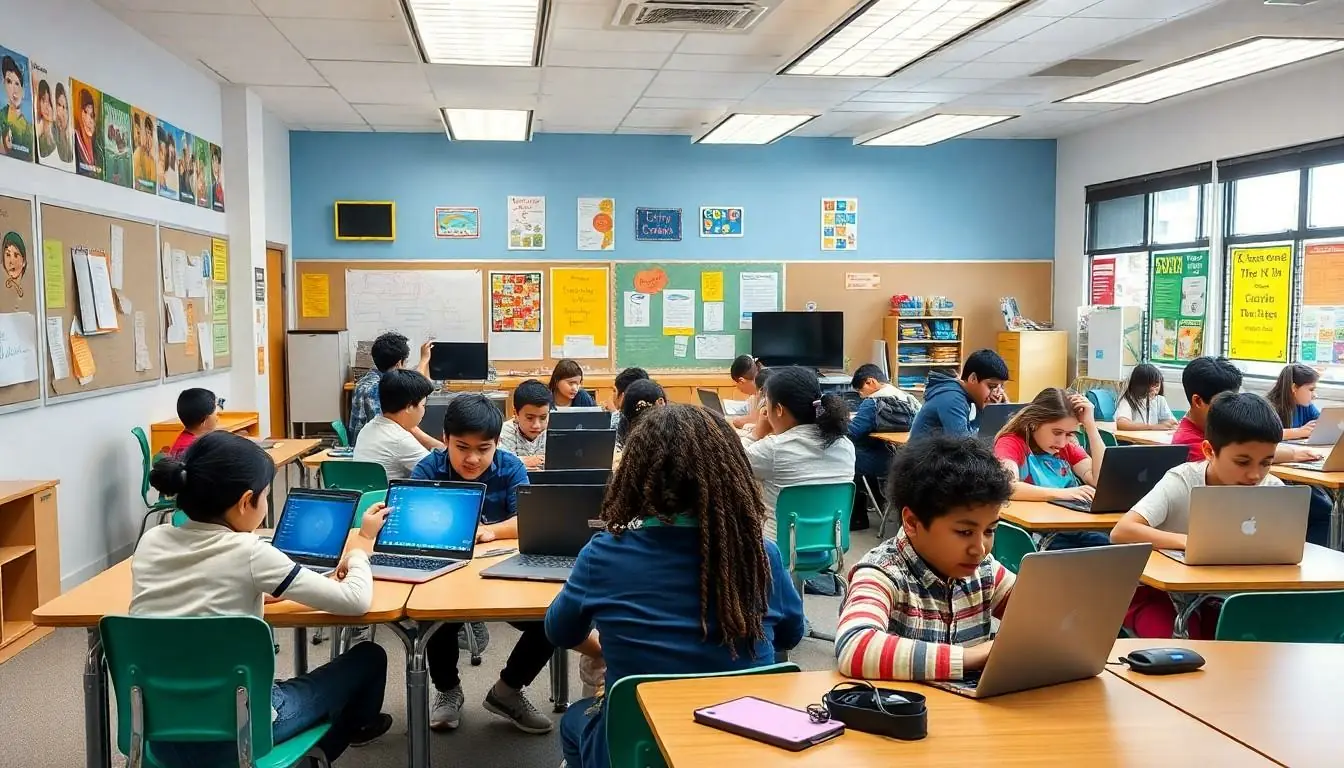In today’s tech-savvy world, K-12 computers are more than just fancy gadgets; they’re the secret sauce to a successful education. Imagine a classroom where students aren’t just staring at chalkboards but diving into a digital wonderland of knowledge. With the right computer, learning transforms from a chore into an adventure, and who wouldn’t want that?
Table of Contents
ToggleOverview of K12 Computers
Computers serve as crucial tools within K-12 classrooms. They enhance the learning experience by providing access to a wealth of digital resources. Modern classrooms incorporate devices like laptops, tablets, and desktops, ensuring students engage meaningfully. Interaction with technology motivates learners, making education more dynamic and interactive.
Learning is tailored through various educational software programs compatible with K-12 curricula. Programs include those focused on mathematics, science, and language arts, designed to meet diverse student needs. Teachers utilize these tools for assessments, enabling customized feedback that aids student progress.
Integration of computers into everyday lessons improves collaboration. Students work together on projects, using shared documents and presentations to foster teamwork. Real-time communication and collaboration tools bridge gaps between classroom and remote learning, allowing seamless interaction.
Support for personalized learning is another benefit of K-12 computers. Resources like adaptive learning platforms adjust content according to student performance. This approach helps identify strengths and weaknesses, ensuring focused instruction and maximized learning potential.
Furthermore, exposure to technology prepares students for future careers. Digital literacy skills gained in K-12 education are essential in today’s job market. Understanding software, programming, and online communication equips students for various professional fields.
Implementation of computers in education promotes inclusivity. Students with disabilities benefit from specialized software that aids in learning. Computers can adapt to individual needs, ensuring every student has an equal opportunity to succeed.
K-12 computers also facilitate access to global information. Online databases and resources broaden perspectives beyond local content, encouraging research and critical thinking skills. As technology continues to evolve, its role in education remains integral, further shaping the future of K-12 learning.
Key Features of K12 Computers

K12 computers come equipped with essential features tailored for educational environments. These specifications ensure optimal performance for both students and teachers.
Performance Specifications
K12 computers typically include robust processors, such as Intel Core or AMD Ryzen, enabling smooth multitasking. RAM ranges from 4GB to 16GB, accommodating various educational software demands. Storage options often include SSDs for fast boot times and efficient data retrieval. Battery life remains crucial, with many models lasting up to 10 hours, supporting full-day use without frequent recharging. Operating systems like Windows or Chrome OS offer compatibility with numerous applications. Additionally, lightweight designs promote portability, making it easier for students to transport devices between classes.
Educational Tools and Software
K12 computers feature educational software specifically designed for student engagement. Learning management systems enable teachers to distribute materials, track progress, and communicate seamlessly. Collaborative platforms, like Google Workspace and Microsoft Teams, enhance group projects and foster teamwork. Specialized programs focus on subjects such as coding, math, and science, aiding personalized learning experiences. Digital libraries grant access to countless resources, promoting research capabilities. Many devices also include accessibility features, supporting students with diverse needs. Software updates ensure security and technical support, safeguarding educational environments.
Benefits of Using K12 Computers
K12 computers significantly enhance the educational landscape by making learning more engaging and interactive. They provide students with a wide array of digital resources, fostering a deeper understanding of subjects. Interactive software programs allow for dynamic lessons that capture attention. Real-time assessments help teachers monitor progress and adjust instruction accordingly. Access to diverse materials promotes exploration and encourages critical thinking.
Collaboration becomes seamless with tools like shared documents and communication platforms. Students learn to work together, whether in person or remotely. This collaboration helps develop cooperative skills essential for future career success.
Enhancing Learning Experiences
K12 computers actively engage students through interactive lessons and multimedia content. Videos, simulations, and gamified activities create an immersive environment that enriches understanding. Such tools facilitate immediate feedback, allowing students to grasp concepts quickly. In addition, online quizzes measure comprehension in real-time. Educators can access learning analytics to tailor instruction, optimizing learning experiences further. As a result, students exhibit increased motivation and enthusiasm for learning.
Supporting Diverse Learning Styles
K12 computers cater to various learning preferences by offering personalized educational experiences. Digital platforms accommodate visual, auditory, and kinesthetic learners with diverse content formats. For instance, video tutorials benefit visual learners, while podcasts support auditory types. Hands-on activities in coding applications engage students who thrive on interactivity. The flexibility of technology creates avenues for differentiated instruction, ensuring that all students receive support tailored to their unique needs. Ultimately, these resources foster an inclusive environment where every learner can succeed.
Challenges and Considerations
Implementing computers in K-12 education involves various challenges and considerations that educators and administrators face. Understanding these factors is essential for successful integration.
Cost and Budget Constraints
Budget limitations often impact the availability of computers in schools. Many districts must prioritize spending, making cost a significant consideration. Investing in quality devices with necessary software can exceed budget allocations, necessitating careful financial planning. Grants and donations can supplement purchasing efforts, allowing access to crucial resources. Schools frequently explore bulk purchasing options to minimize expenses. Lower-cost alternatives may limit functionality, posing risks to educational outcomes. Funding models should align with the school’s overall technology strategy to ensure long-term sustainability.
Technical Support and Maintenance
Technical support plays a critical role in maintaining K-12 computer systems. Frequent issues can disrupt learning activities, so responsive support teams are essential. Training staff on basic troubleshooting can alleviate minor problems, ensuring smooth operation. Regular maintenance schedules help prolong the lifespan of devices, reducing replacement costs. Collaboration with IT vendors can provide professional support when specialized expertise is required. Planning for updates and upgrades forms part of an effective maintenance strategy, ensuring the technology remains current and functional. Schools should consider resource allocation for ongoing support to maximize the benefits of computer integration.
K-12 computers are reshaping the educational landscape by making learning more engaging and interactive. They empower students with access to digital resources that enhance understanding and foster collaboration. As technology evolves, these tools become even more integral to education, preparing students for future career opportunities and promoting inclusivity.
While challenges like budget constraints and technical support exist, the benefits of integrating computers into K-12 education far outweigh the obstacles. Schools must prioritize effective planning and training to maximize the potential of these devices. Embracing technology in the classroom not only enriches the learning experience but also equips students with essential skills for success in a digital world.





